
6 minute read
to Me
WHAT MEANS TO ME

Advertisement
My surfing journey started in 2018 on the island of Oahu, Hawaii in Waikiki beach. I was staying with a family that lived in Honolulu at the time, and I decided to take surfing lessons as it had always interested me. We all grew up with movies like Soul Surfer, Blue Crush, and Surfs Up— you know, the classics. I have always dreamt of learning how to be able to cut through the water on a board and experience what that feels like. My first surf lesson in Waikiki had me over the moon. I was able to get up and surf in Hawaii! I arrived at UNCW that same year and bought my first surfboard. I went out on my new ride excited to surf again, and I sucked. My heart was broken. After learning in Hawaii, suddenly I couldn’t stand up? I tried again the next day, and the next, and the next. 3 months later I figured it out again. Through all of my frustrating days, I finally got the hang of surfing again. A couple of years and a few boards later, I have continued to practice and fall in love with surfing a little more each day.
For me, surfing is an experience like no other. When I am sitting on my board with other surfers in complete silence, it’s never awkward... It is more of a meditative silence where I feel at peace and very close to the ocean. When I am in the ocean on my board looking for the next wave, all my focus is on that next surf I do not think about my upcoming test or my shift at work, it’s just me and the waves. When I finally catch that perfect wave, it’s almost as if I am flying through the water. Once I am in a wave, I am hit with a sense of excitement. It is where I can fully let go and be one with the ocean. Through surfing, I have met so many incredible people who encourage me to strive to become better every day. Being a part of a community where you become close with the love for the ocean and what it gives us is something I try to never take for granted.
If you are thinking about trying to learn to surf but you are too afraid that you won’t be able to or that you’ll fail... You will! That is the entire point of beginning’s. Alana Blanchard, Bethany Hamilton, Carissa Moore, these are names we all know, but also names of women who all had to start somewhere to become as legendary as they are today. They all had to nosedive into a wave, hit their head on their board, and get completely rocked. They all had to get frustrated at themselves while they learned, but every single one of them would agree that it was worth it. I have been only surfing for 3 years of my life, but I can no longer imagine my life without surfing. It’s never too late to learn. No matter
your age, size, or athletic ability, I promise you if you are wanting to try to learn how to surf, you should.
Living in Wilmington, NC, so close to Wrightsville Beach, there are so many resources to get started with surfing. With a simple google search, you can find numerous group surfing lessons, individual lessons, or you can ask one of your friends who knows how to surf. By getting comfortable with the foundations of surfing through lessons, practicing will become so much easier. Take a chance on yourself and learn how to surf. Who knows, maybe you’ll become the next Alana Blanchard.
WRITTEN by Autumn Rice DESIGNED by Jordan Mays

The Little Guide to House Plants
WRITTEN by Ally Jones // DESIGNED by Jordan Mays
House plants are having their time at the moment. When the world went on lockdown and humanity migrated indoors last spring, there was no shortage of ideas for indoor hobbies. One of the most popular? Taking care of plants. This is a favorable hobby to pick up, as indoor plants do more than just look good - they can make us feel good, too. According to thesill.com, studies have shown that houseplants can… –have positive effects on mood, productivity, concentration, and creativity –reduce stress, fatigue, sore throats & colds –clean indoor air by absorbing toxins, increasing humidity & producing oxygen –add vibrancy to a sterile space, give privacy and reduce noise levels

There are many houseplants available for public purchase, from the common and vibrant Pothos to the finicky and tropical Calathea, botanists are given a wide variety of species to choose from. Although to a beginner, facing these options may have you feeling out of depth. If you identify with the latter of the two, rest assured, this beginner’s guide to caring for indoor plants is for you.
House plants require different levels of sun, water, and care. Though this may seem obvious, a common misconception in plant-care is all species love direct sunlight and loads of water. In reality, most plants enjoy bright, but indirect light, as leaves are susceptible to burning. In terms of watering, different factors come into play.
If your new plant originally derives from a tropical region, it enjoys soil to stay evenly moist, but not wet, as well as high humidity (this can be accomplished by misting leaves and grouping plants together on top of a tray of pebbles and water). On the other hand, plants that naturally grow in drier climates prefer their soil to dry completely before being watered again. The water used on your plant is also important. Tap water can be harmful to plants, as it is frequently alkaline (“hard” or high in calcium) and often contains chlorine and fluoride. Think of it this way, if you wouldn’t drink it, why should your little green friend? Go purchase some distilled/filtered water, your plants will thank you.
Another important factor in your plant’s happiness is its home. While it may be tempting to buy that adorable $20 planter at Target, it may be more beneficial to keep your plant in the plastic container you bought it in. Why? First off, many plants only need to be repotted every 1218 months, depending on how much they are growing. Secondly, these little plastic pots they are sold in provide the plant with drainage holes (the small circle-shaped cuttings at the bottom of the planter). Drainage is essential for the well-being of potted plants, as it allows excess water to seep out of the planter after watering. This ensures that water does not sit at the bottom of the pot, which can lead to root-rot (a disease in plants, in which the roots of a plant rot and decay) as well as fungus and bacterial growth. Of course, this isn’t true for all plants, especially those that grow quicker and need more room sooner.
Now, with these basics down, we’re going to provide you with some lowmaintenance (but still lovely) plants to get you in the swing of things. Hopefully, these tips will have you feeling a little less anxious next time you hit the local nursery. Good luck and happy planting! Golden Pothos Vine // Epipremnum aureum Spider Plant // Chlorophytum Snake Plant // Dracaena trifasciata Lucky Bamboo // Dracaena sanderiana Dumb Cane // Dieffenbachia











